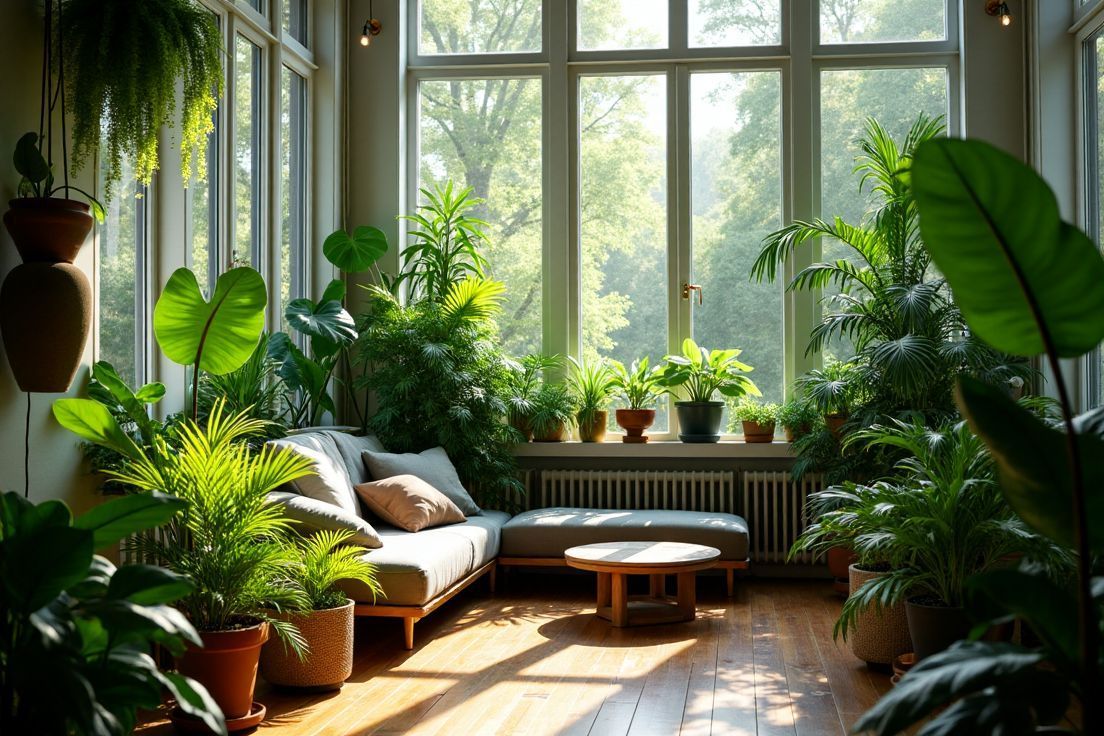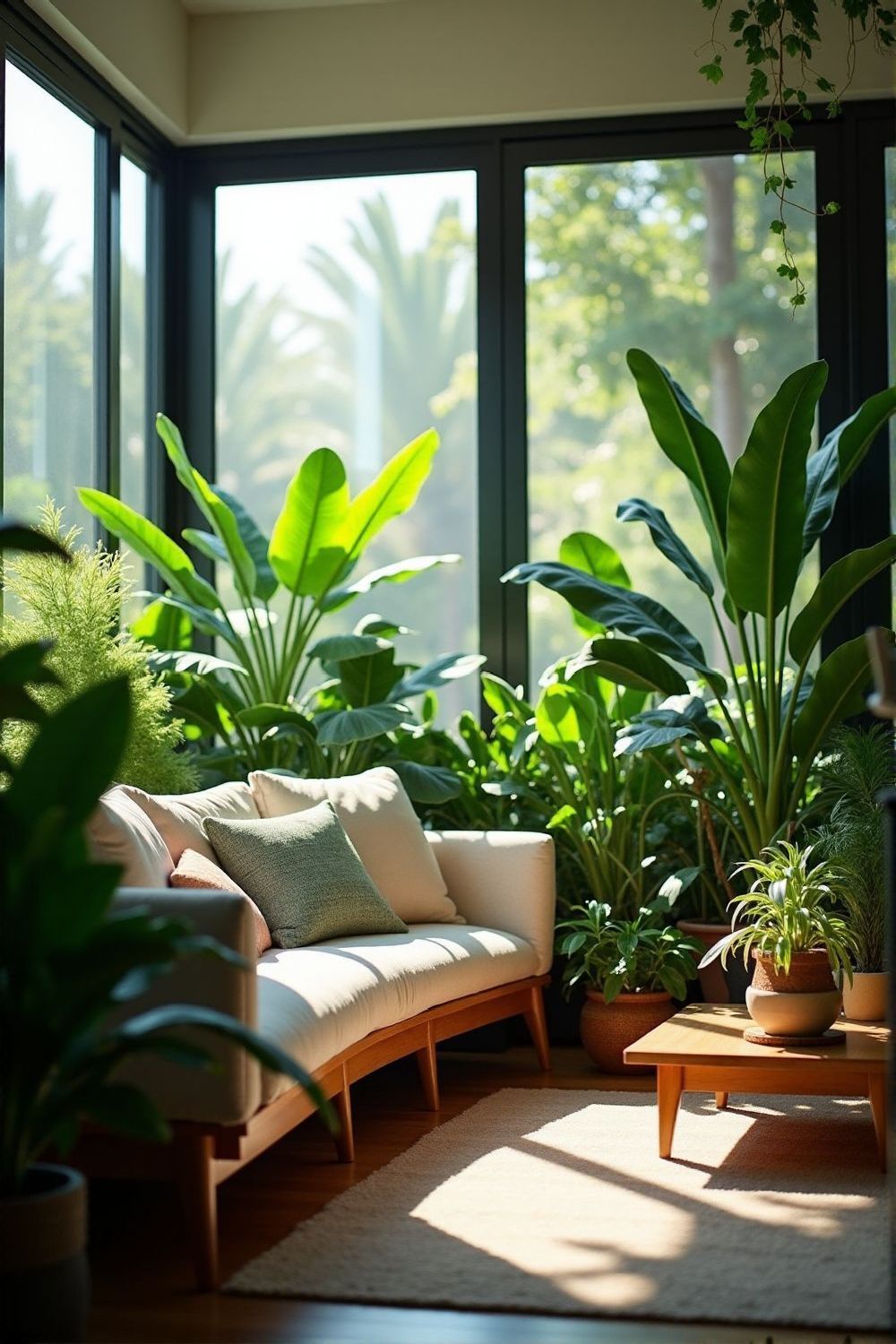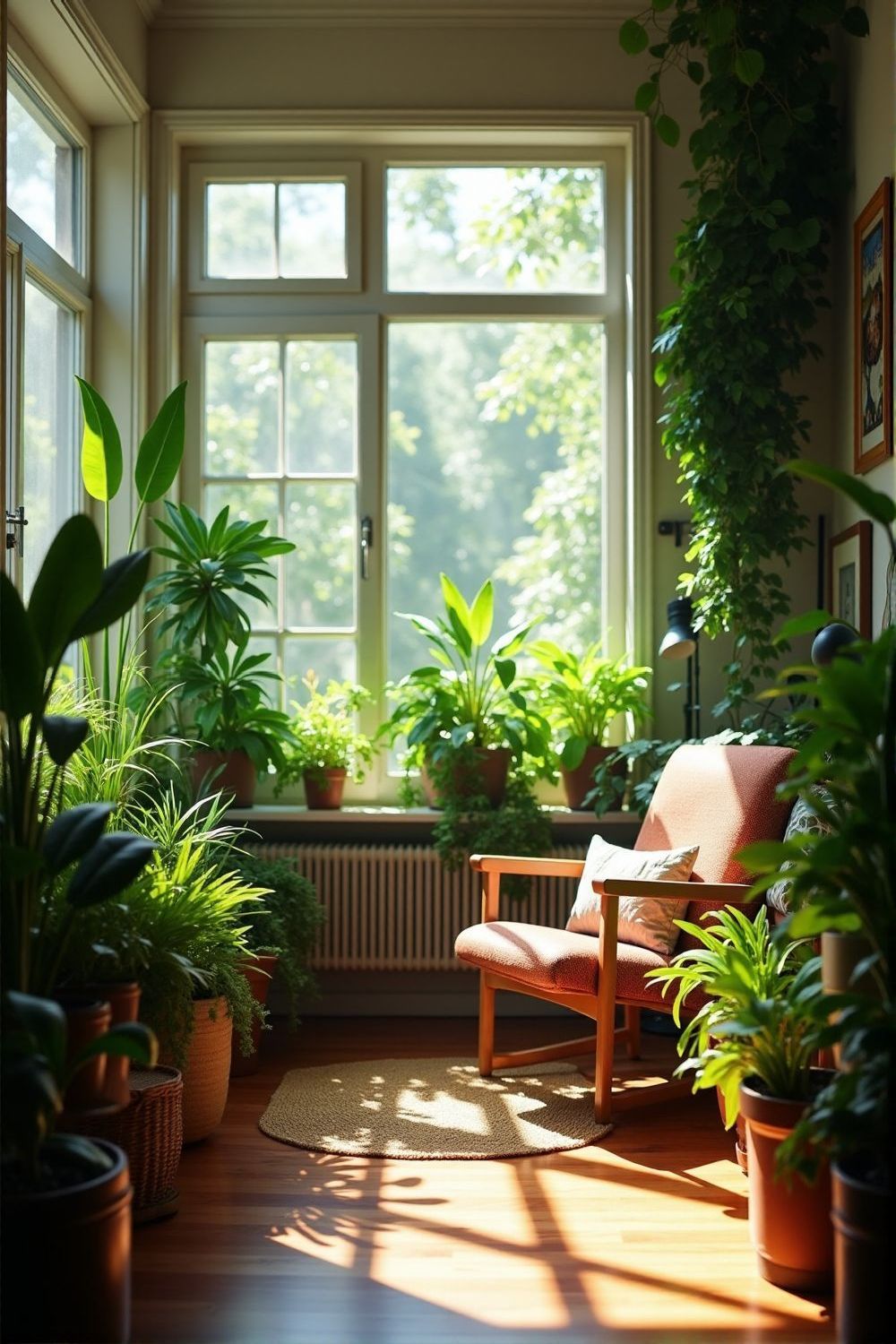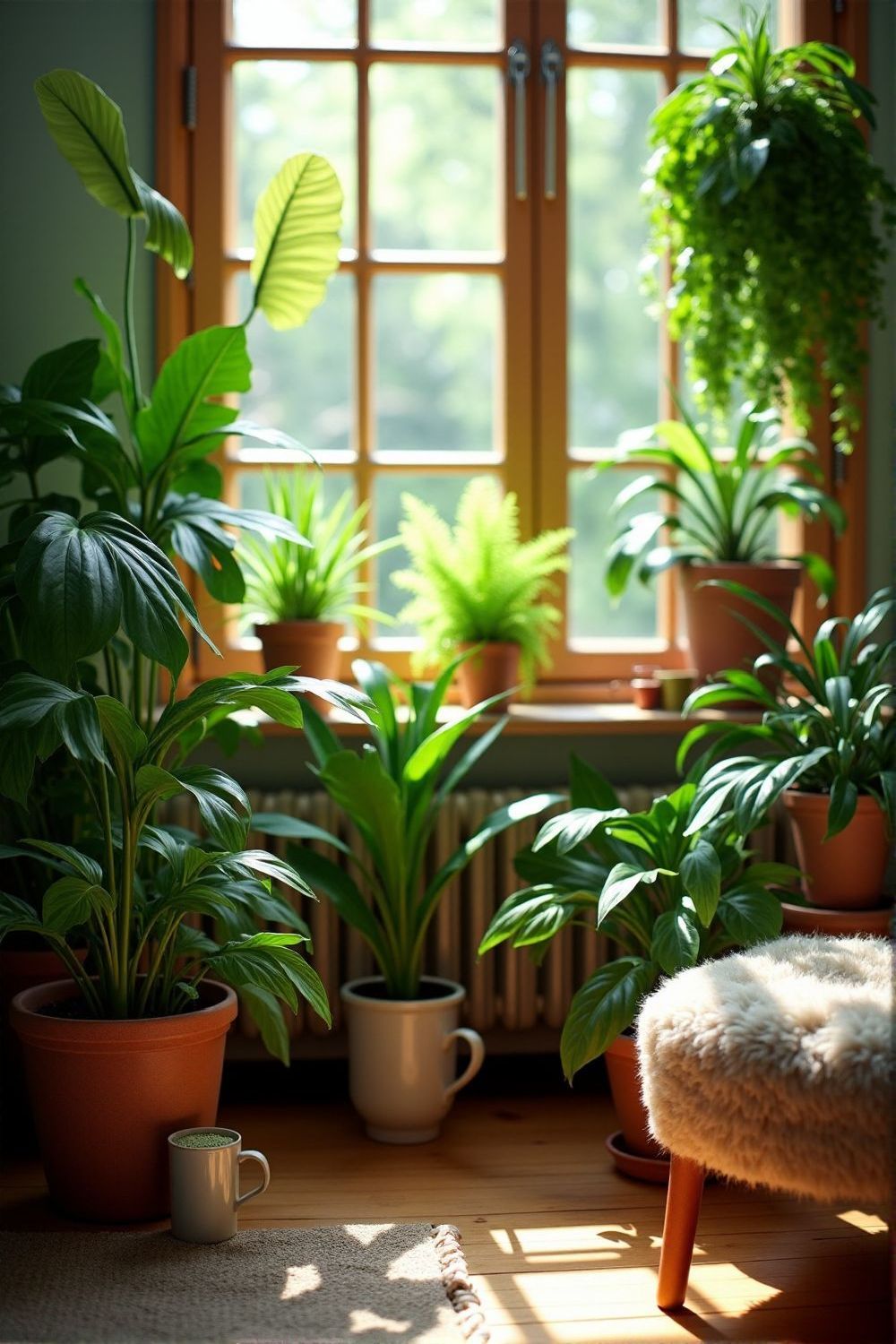
In this blog post, we will explore tips and tricks for choosing the right plants and arranging them for maximum beauty and health. From selecting the ideal indoor plants to using decorative pots, there’s so much you can do to make your green space thrive!
Let’s dive into how you can transform your surroundings into a vibrant and refreshing sanctuary.
Create a Lush Green Space

Creating a lush green space can transform any area into a beautiful oasis. Start with choosing a variety of plants.
Consider adding ferns, succulents, and flowering species to bring color and texture. Grouping plants together by their water and light needs ensures they thrive.
When planning a garden or indoor plant arrangement, it’s important to consider the needs of each plant species to ensure they thrive. Below is a table that outlines various plant types, their water needs, light preferences, and potential color contributions.
| Plant Type | Water Needs | Light Preferences | Color Contribution |
|---|---|---|---|
| Ferns | Moderate | Indirect light | Green lush foliage |
| Succulents | Low | Bright light | Varied hues (green, pink, red) |
| Flowering Plants | Moderate to High | Direct or indirect light | Colorful blooms |
| Ornamental Grasses | Low to Moderate | Full sun | Green and tan tones |
| Herbs | Moderate | Full sun | Green foliage, occasional flowers |
| Tropicals | High | Bright indirect light | Vibrant greens and colorful flowers |
Use pots and containers to add height and interest. You can layer plants from tall to short to create a dynamic look.
Adding decorative stones or pebbles can enhance the visual appeal while also helping with drainage. Incorporating a small water feature, like a fountain, not only adds tranquility but also attracts birds.
Lighting is essential, too. Soft lights can highlight your plants at night, making the space inviting even after sunset.
Don’t forget to create pathways. Using stepping stones or gravel can make it easy to walk through your space without damaging your plants.
Regularly pruning and taking care of your greenery will keep your area looking fresh and lively. Enjoy the space as it grows and evolves with time!
Choose the Right Indoor Plants
Choosing the right indoor plants is key to creating a vibrant space. Think about your home’s lighting conditions.
Choosing the right indoor plants is essential for enhancing your living space and improving overall well-being. Here are some tips to consider:
- Assess natural light levels in each room to select plants that thrive in those conditions.
- Consider low-light plants like snake plants or pothos for darker areas of your home.
- Choose brighter spaces for light-loving plants such as succulents or cacti.
- Think about humidity levels; tropical plants may require more moisture in the air.
- Incorporate a mix of plants to create visual interest and a balanced atmosphere.
Plants that need bright light won’t do well in dark corners. Low-light plants are excellent for those areas.
Consider the size of your space. If you have limited room, opt for smaller plants like pothos or snake plants.
They take up less space but still add plenty of greenery. For larger areas, you might want bigger plants like rubber trees or fiddle leaf figs.
Your lifestyle matters too. Busy people may prefer low-maintenance plants that require less watering.
Succulents and ZZ plants are great choices. They thrive on neglect, making them perfect for anyone short on time.
Lastly, think about what you want from your plants. Do you prefer lush foliage, colorful flowers, or unique shapes?
Select a mix that fits your design vision and personality. The right combination will create an inviting and lively atmosphere indoors.
Utilize Vertical Space Effectively
Using vertical space can make a big difference in how your indoor plants look and how much you can fit in your space. Think about wall-mounted shelves or plant hangers.
These can add layers to your greenery without taking up floor space.
Use plant stands to create height.
This adds dimension and keeps smaller plants off the ground, allowing them to get the light they need. You can also mix different heights on a shelf for a more interesting look.
Vertical gardens are another fun option. They consist of plants arranged vertically on a wall.
These can be made with various materials, like wood or metal frames, giving a unique touch to any room.
Don’t forget about climbing plants!
Vines, like pothos and ivy, can climb up trellises or walls, adding a lush feel. Use hooks or nails to help them grow upwards.
Arrange your plants in groups at different heights. This creates a fuller appearance and draws the eye upward, making the room feel larger.
Finally, adding artwork or mirrors behind your plants can enhance the vertical effect. Mirrors create the illusion of more space and reflect the beauty of your plants, making them pop even more.
Incorporate Decorative Pots and Planters
Decorative pots and planters can greatly enhance the look of your indoor plants. They come in various shapes, sizes, and colors, allowing you to express your style.
A colorful pot can turn a simple green plant into a focal point in a room.
Think about choosing pots that match your home decor.
For a modern look, sleek ceramic pots work well. If you prefer a rustic vibe, consider terracotta or wooden planters.
Mixing different styles can also create an interesting visual contrast.
Don’t forget about the size of the pots.
Bigger plants need larger containers to thrive. Conversely, smaller plants can flourish in delicate pots.
Place taller plants in the back and shorter ones in front to create depth.
Adding unique planters like hanging pots can free up space while adding charm.
Wall-mounted planters or shelves can give your plants a special spot, making your space feel lively.
Consider using pots with interesting textures or patterns.
Enhancing your indoor or outdoor space with wall-mounted planters or shelves not only elevates the aesthetics but also creates a vibrant atmosphere. Here are some ideas to consider:
- Choose a variety of plants with different sizes and colors for an eye-catching display.
- Mix and match pots with varying heights to create an interesting visual dynamic.
- Incorporate trailing plants that can drape gracefully from the shelves.
- Use pots that complement your existing decor style, whether it’s modern, rustic, or bohemian.
- Don’t forget the importance of adequate sunlight and drainage for your plants’ health.
These details can add character and enhance the overall appearance of your green space.
Always keep your plant’s growth in mind when choosing pots.
Some plants may need more room as they grow. Choosing the right size container can prevent the roots from getting cramped and will help your plants thrive.
Enhance Natural Light Use

South-facing windows get the most light, while north-facing ones receive the least. Observe how the light changes throughout the day to determine the best spots for your plants.
Place light-loving varieties, such as succulents and cacti, near these brighter areas.
Utilize sheer curtains or blinds that can be easily opened during the day.
This allows natural light to flood in without completely blocking it. If you have a room that doesn’t get much light, try reflective surfaces like mirrors or shiny decor.
They can bounce light around your space, brightening up dark corners.
Consider using light shelves.
These are shelves specifically designed to hold plants and provide them with extra light. You can install grow lights above them for plants that crave more sunshine.
Grow lights come in various types, and some mimic natural sunlight, benefiting your greenery.
Maintaining your window cleanliness also helps maximize light.
Dusty windows can block a significant amount of sunlight. Clean them regularly to keep that light flowing.
You could also rearrange your plant collection as seasons change. This ensures each plant gets its fair share of sunshine throughout the year.
By paying attention to natural light, you can create a lively indoor environment. Your plants will flourish and bring vibrant life into your home.
Maximize Sunlight with Windows
This information is key for placing your plants where they can absorb the most light.
For windows that don’t get much direct sunlight, think about using sheer curtains.
They let light in while softening harsh rays. Another clever trick is to position mirrors near windows.
Mirrors reflect light and can brighten up the room significantly.
If your plants need more light, consider using window sills as plant shelves.
You can stack smaller pots or place trays to hold multiple plants. This way, you take advantage of the sunlight streaming through the glass.
Always remember to keep your windows clean. Dust can block light, reducing the amount that reaches your plants.
Regular cleaning ensures they get ample sunlight.
As seasons change, so does sunlight exposure.
Adjust your plant placements accordingly. Move them closer to windows in winter when light is limited, and back to their spots in spring and summer when the sun is stronger.
Proper placement of your houseplants throughout the seasons is essential for their health and growth. Here are some tips to consider when adjusting their locations:
- Monitor light levels in your home during different seasons.
- Choose south-facing windows for maximum light exposure in winter.
- Gradually acclimate plants to stronger sunlight in spring to avoid shock.
- Consider using sheer curtains to diffuse harsh sunlight during the summer.
- Rotate plants regularly to ensure even growth and light distribution.
Lastly, try using a light meter app on your phone to measure light levels. This can help make informed decisions about which plants will thrive in specific spots of your home.
Maximize Plant Potential in Dim Spaces with Grow Lights
There are various types of grow lights available, including LED, fluorescent, and incandescent options. Each type has its benefits, but LEDs are often preferred due to their energy efficiency and longer lifespan.
When setting up grow lights, consider the distance from the plants. Typically, placing the lights 12 to 24 inches above your plants works well.
This distance helps ensure the light reaches the leaves without causing damage. You can adjust the height as the plants grow to keep them healthy and nourished.
It’s also helpful to establish a light schedule. Most plants thrive with around 12 to 16 hours of light each day.
Use a timer to make it easier, so the lights turn on and off automatically. This regular exposure mimics natural sunlight and supports healthy growth.
Moreover, pay attention to the specific needs of your plants. Some may prefer softer light, while others might appreciate brighter conditions.
Adjusting the type and intensity of the grow lights can accommodate these differences, ensuring each plant receives the optimal care.
By utilizing grow lights, you can create a vibrant indoor garden, even in spaces that might not receive adequate natural light.
This approach not only enhances the aesthetics of your home but also supports diverse plant life, allowing them to flourish and add a lively touch to your surroundings.
Position Plants for Optimal Exposure
Bright spots are ideal for sunlight-loving plants like succulents and cacti. For darker corners, opt for low-light plants, such as snake plants or pothos.
Choosing the right plants for your home depends on the amount of natural light available. Here are some suggestions for bright spots and darker corners:
- Bright spots are ideal for sunlight-loving plants such as succulents and cacti, which thrive in direct sunlight.
- Consider colorful flowering plants like geraniums or African violets for sunlit areas to add vibrant colors to your space.
- In darker areas, snake plants are excellent as they require minimal light and help purify indoor air.
- Pothos plants are also great for low-light conditions; they are easy to care for and can grow in various light settings.
- For low-light spots, ZZ plants and peace lilies could be perfect, as they are resilient and adapt well to limited lighting.
Consider using plant stands or shelves to elevate your greenery. Higher placements can allow plants to soak up more light, especially when positioned near windows.
Grouping plants with similar light needs together can create a vibrant display while fostering health.
Avoid placing tall plants in front of shorter ones if they block light.
Instead, arrange them by height, with larger varieties at the back or on higher surfaces. This way, each plant can receive adequate light, promoting growth.
Be mindful of seasonal changes in sunlight. As the seasons shift, the angle of the sun changes too.
You may need to adjust plant positions periodically to maximize light exposure throughout the year.
If natural light is limited, consider using grow lights to supplement.
These can ensure your plants thrive even in dimly lit spaces. Placing grow lights at the right distance from your plants will help create a welcoming environment for them.
Regularly monitor how plants react to their light situations. Yellowing leaves may indicate too much light, while leggy growth suggests they need more.
Adjust accordingly to keep your plants healthy and thriving.
Maintain Plant Health Easily

First, check the soil regularly. Make sure it’s the right moisture level.
Overwatering is a common mistake. Always allow the top inch of soil to dry out before watering again.
This will help prevent root rot and keep your plants happy.
Next, consider using a routine feeding schedule.
Fertilizing your plants every few weeks can give them the nutrients they need to grow strong. Use a balanced fertilizer suited for indoor plants.
To ensure your indoor plants thrive and flourish, regular fertilization is essential. Here are some key points to consider when fertilizing your plants:
- Choose a fertilizer with equal ratios of nitrogen (N), phosphorus (P), and potassium (K) for balanced nutrition.
- Water your plants before applying fertilizer to prevent root burn and promote nutrient absorption.
- Observe your plants for signs of nutrient deficiency, such as yellowing leaves or stunted growth.
- Follow the manufacturer’s instructions on the fertilizer package for proper dosage and frequency.
- Consider using organic fertilizers for a more natural nutrient source that benefits both plants and the environment.
Following the instructions on the package can help you avoid overdoing it.
Pest control is another key factor.
Inspect your plants weekly for any signs of bugs. If you see any, act quickly to get rid of them.
Many pests can be managed with natural solutions, like neem oil or insecticidal soap. These can protect your plants without harsh chemicals.
Keep an eye on the leaves, too. Yellowing leaves may indicate a problem, such as too much water or not enough light.
Pruning dead or damaged foliage will help the plant focus its energy on healthy growth. It also keeps your indoor jungle looking neat and tidy.
Lastly, consider grouping plants together. This can increase humidity, which many tropical plants love.
A little extra moisture in the air can lead to healthier, happier plants. Make sure to rotate them occasionally so each gets a fair share of sunlight.
Establish a Watering Schedule
Some require more water, while others thrive on less. A good start is to check the soil moisture regularly.
Stick your finger into the soil about an inch deep. If it feels dry, it’s time to water.
Properly checking the moisture level of your soil is essential for the health of your plants. Here are some key points to keep in mind:
- Check the soil moisture regularly, especially during hot or dry weather.
- A soil moisture meter can provide accurate readings if you prefer not to use your finger.
- Water plants early in the morning or late in the evening to minimize evaporation.
- Consider the type of plant; some prefer drier soil while others thrive in consistently moist conditions.
- Ensure good drainage to prevent root rot; overly wet soil can be as detrimental as dry soil.
It’s helpful to water your plants at the same time each week. This creates a habit for you and keeps your plants on a routine.
Early morning or late afternoon are often the best times to water. This way, the water has time to soak in before it heats up too much during the day.
Consider using a plant calendar or app. These tools can remind you when to check your plants.
You can also note down how much water each plant needs. Over time, you’ll learn which plants require more attention.
Keep in mind that the size of the pot affects how often you water. Larger pots hold moisture longer than smaller ones.
Also, factors like humidity and temperature can change how quickly the soil dries out. During hot months, plants may need additional watering.
Finally, always water until it flows out of the bottom of the pot. This ensures all roots get enough moisture.
Following these simple steps will help your indoor plants flourish and stay healthy.
Monitor Humidity and Temperature Levels
If the air is too dry, your plants might suffer. You can increase humidity by using a humidifier, placing a tray of water near your plants, or misting them with water occasionally.
Grouping plants together can help, too, as they release moisture into the air through a process called transpiration.
Temperature matters just as much.
Many plants prefer a range of 65F to 75F during the day and slightly cooler at night. If your home gets too hot, especially in the summer, it can stress your plants.
Make sure they are not near heat vents or in direct sunlight during the hottest part of the day. A consistent temperature is key-as too many fluctuations can lead to problems.
To keep track of these levels, consider using a hygrometer for humidity and a thermometer for temperature. Knowing these conditions allows you to make adjustments for the best plant health.
Remember, plants are living things that need the right environment to grow well. Regular monitoring will help you create a thriving indoor jungle, ensuring each plant gets what it needs to flourish.
Fertilize Plants Regularly and Wisely
Look for one that has balanced nutrients, which means it contains nitrogen, phosphorus, and potassium. This combination supports overall plant development.
When selecting fertilizers for your plants, understanding the importance of nutrient balance is key. Here are some essential points to keep in mind:
- Ensure that the fertilizer has equal or appropriate ratios of nitrogen (N), phosphorus (P), and potassium (K) for optimal growth.
- Nitrogen promotes healthy leaf and stem growth, contributing to the overall vigor of the plant.
- Phosphorus is vital for root development and flowering, enhancing both yield and quality of produce.
- Potassium helps regulate water usage and enhances disease resistance, making plants more resilient.
- Choose a fertilizer that suits the specific growth stage of your plants, as nutrient needs can vary throughout their lifecycle.
Apply the fertilizer according to the instructions on the package. Over-fertilizing can harm your plants, causing burnt roots and unhealthy growth.
It’s better to under-fertilize than to overdo it.
Timing matters too.
Common practice is to fertilize every few weeks during the growing season, usually spring and summer. In fall and winter, many plants slow down, so they need less food.
Remember to water your plants before adding fertilizer. This prevents root damage and helps them absorb nutrients better.
Keep an eye on your plants. If you notice yellowing leaves or stunted growth, they might need more nutrients.
Organic options are available as well and can be a great choice. These fertilizers support healthy soil and plant growth without harsh chemicals.
Fertilizing wisely helps your indoor jungle thrive. Healthy plants will be more resilient and look beautiful in your space.
Frequently Asked Questions
Welcome to our FAQ section where we address some common questions about maintaining lush green spaces and creating a vibrant indoor environment with plants.
What types of plants are best for low-light areas?
For low-light areas, plants like snake plants and pothos are excellent choices. They thrive in minimal light and are very forgiving, making them ideal for darker corners of your home.
These plants are not only easy to care for but also help purify the air, enhancing your indoor environment. Consider incorporating them into your space to liven up areas that do not receive much natural sunlight.
How can I create a visually appealing indoor garden?
To create a visually appealing indoor garden, consider using pots of varying heights and styles. Mixing different shapes, sizes, and colors can be used to express your personal style and make the plants stand out.
Incorporating climbing plants and layering your greenery will also add depth and interest. Additionally, grouping plants with similar care needs can create a harmonious look while simplifying maintenance.
What is the importance of proper watering techniques for plants?
Proper watering techniques are crucial for the health of your plants. Overwatering can lead to root rot, while underwatering can cause plants to wilt and suffer.
A good rule of thumb is to check the soil moisture regularly and water only when the top inch of soil feels dry. This practice ensures that plants receive adequate hydration without risking damage from excess moisture.
How do I determine my plants’ light requirements?
To determine your plants’ light requirements, observe the natural light levels in your home throughout the day. Bright spots are best for sunlight-loving plants like succulents, while low-light plants thrive in dimmer areas.
Using a light meter app can help you gauge how much light each area of your home receives. Adjusting light exposure according to each plant’s needs is essential for their successful growth.
What are effective ways to maintain humidity for indoor plants?
Maintaining humidity is vital for the health of many indoor plants, especially tropical varieties. You can increase humidity by using a humidifier, grouping plants together, or placing a tray of water near your greenery.
Misting your plants occasionally can also help, although be cautious not to overdo it. Monitoring humidity levels with a hygrometer will give you insights into making necessary adjustments for your indoor garden.
Why is fertilizing important, and how often should I do it?
Fertilizing is essential for providing plants with the nutrients they need for healthy growth. A balanced fertilizer contains nitrogen, phosphorus, and potassium, which support various aspects of plant development.
It is generally advised to fertilize every few weeks during the growing season, while reducing frequency in fall and winter when many plants slow down. Always follow the manufacturer’s instructions to avoid over-fertilizing, which can harm your plants.
Conclusion
Remember, caring for plants is a journey. Don’t be afraid to experiment and adjust as you go.
Enjoy the process and watch how your indoor garden flourishes over time. Every effort you make will lead to a more vibrant and refreshing environment in your home!